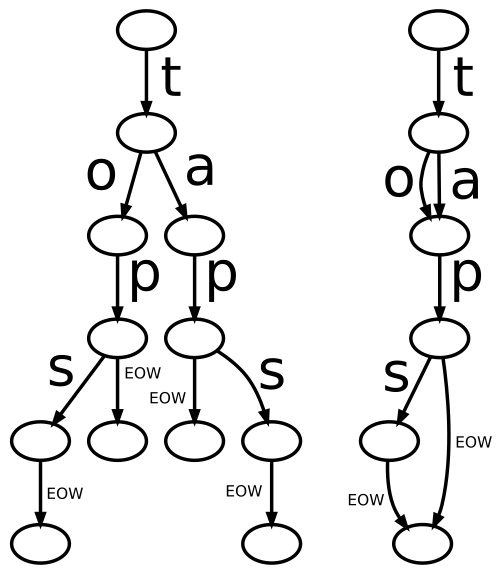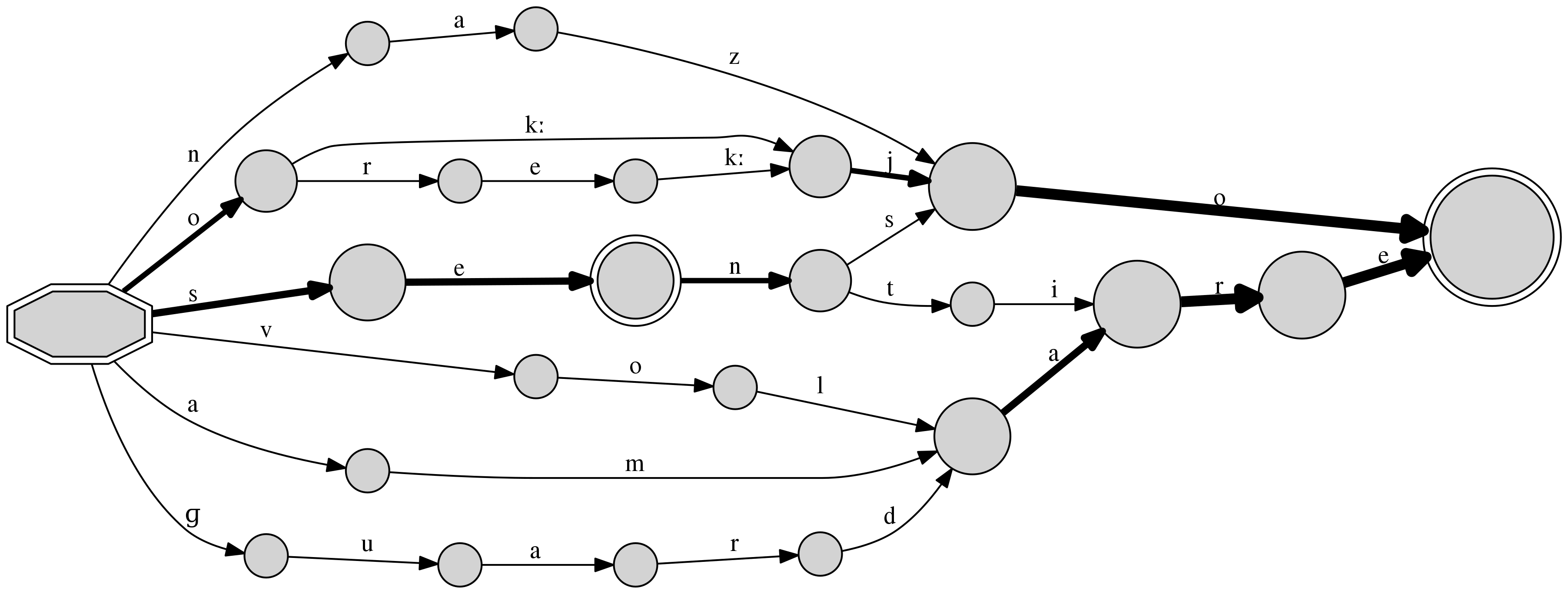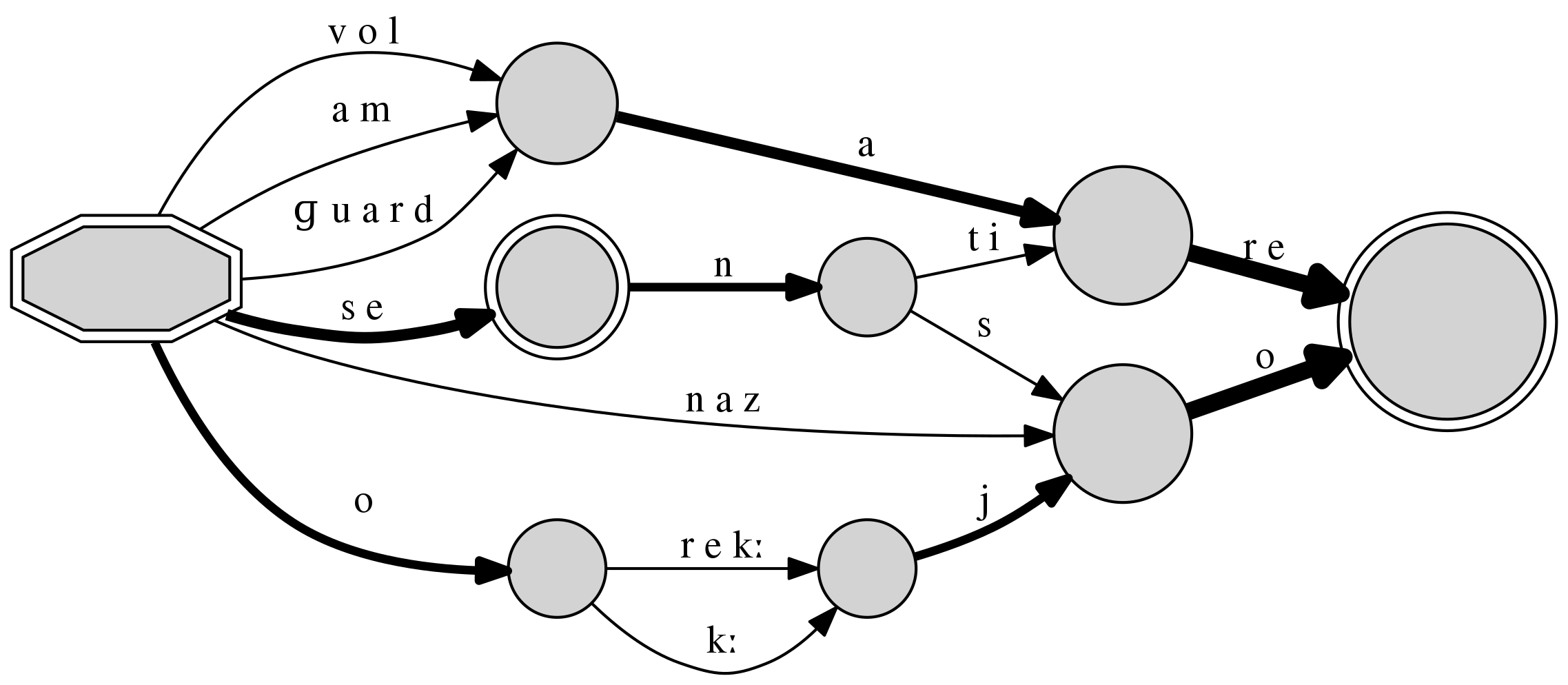Library for computing Deterministic Acyclic Finite State Automata (DAFSA)
Project description
DAFSA
DAFSA is a library for computing Deterministic Acyclic Finite State Automata (also known as "directed acyclic word graphs", or DAWG). DAFSA are data structures derived from tries that allow to represent a set of sequences (typically character strings or n-grams) in the form of a directed acyclic graph with a single source vertex (the start symbol of all sequences) and at least one sink edge (end symbols, each pointed to by one or more sequences). In the current implementation, a trait of each node expresses whether it can be used a sink.
The primary difference between DAFSA and tries is that the latter eliminates suffix and infix redundancy, as in the example of Figure 1 (from the linked Wikipedia article) storing the set of strings "tap", "taps", "top", and "tops". Even though DAFSAs cannot be used to store precise frequency information, given that multiple paths can reach the same terminal node, they still allow to estimate the sampling frequency; being acyclic, they can also reject any sequence not included in the training. Fuzzy extensions will allow to estimate the sampling probability of unobserved sequences.
This data structure is a special case of a finite state recognizer that acts as a deterministic finite state automaton, as it recognizes all and only the sequences it was built upon. Frequently used in computer science for the space-efficient storage of sets of sequences without common compression techniques, such as dictionary or entropy types, or without probabilistic data structures, such as Bloom filters, the automata generated by this library are intended for linguistic exploration, and extend published models by allowing to approximate probability of random observation by carrying information on the weight of each graph edge.
Full documentation is available on ReadTheDocs.io, including detailed instructions on how to use the library.
Installation and usage
For full instructions on installation and usage, please check the OFFICIAL DOCUMENTATION.
In short, the library can be installed as any standard Python library with
pip, and used as demonstrated in the following snippet:
In any standard Python environment, dafsa can be installed with:
>>> from dafsa import DAFSA
>>> print(DAFSA(["dib", "tip", "tips", "top"]))
DAFSA with 8 nodes and 9 edges (4 inserted sequences)
+-- #0: 0(#1/4:<d>/1|#4/4:<t>/3) [('t', 4), ('d', 1)]
+-- #1: n(#2/1:<i>/1) [('i', 2)]
+-- #2: n(#3/1:<b>/1) [('b', 3)]
+-- #3: F() []
+-- #4: n(#5/3:<i>/2|#8/3:<o>/1) [('i', 5), ('o', 8)]
+-- #5: n(#6/2:<p>/2) [('p', 6)]
+-- #6: F(#3/2:<s>/1) [('s', 3)]
+-- #8: n(#3/1:<p>/1) [('p', 3)]
Showcase
- Basic example
- Graphical, ASCII, and Unicode (through third-party applications)
G A
+---------------------+ +----------+
| v | v
#====# C +---+ G +---+ C +---+ G +---+ A +---+ T +---+ A #===#
+-- H 0 H ---> | 5 | ---> | 6 | ---> | 7 | ---> | 8 | ---> | 9 | ---> | 3 | ---> H 4 H
| #====# +---+ +---+ +---+ +---+ +---+ +---+ #===#
| | A ^
| G +-----------+ |
| v |
| +----+ G +---+ A +---+ T |
+-> | 20 | ---> | 1 | ---> | 2 | ----------------------------------------+
+----+ +---+ +---+
Or as Unicode box art:
G A
┌─────────────────────┐ ┌──────────┐
│ ▼ │ ▼
╔════╗ C ┌───┐ G ┌───┐ C ┌───┐ G ┌───┐ A ┌───┐ T ┌───┐ A ╔═══╗
┌── ║ 0 ║ ───▶ │ 5 │ ───▶ │ 6 │ ───▶ │ 7 │ ───▶ │ 8 │ ───▶ │ 9 │ ───▶ │ 3 │ ───▶ ║ 4 ║
│ ╚════╝ └───┘ └───┘ └───┘ └───┘ └───┘ └───┘ ╚═══╝
│ │ A ▲
│ G └───────────┐ │
│ ▼ │
│ ┌────┐ G ┌───┐ A ┌───┐ T │
└─▶ │ 20 │ ───▶ │ 1 │ ───▶ │ 2 │ ────────────────────────────────────────┘
└────┘ └───┘ └───┘
- Without or with single-path joining
Changelog
Version 0.4:
- Full documentation for existing code
- Added GML, PDF, and SVG export
- Allow to access all options from command-line
Version 0.3:
- Allow to join transitions in single sub-paths
- Allows to export a DAFSA as a
networkxgraph - Preliminary documentation at ReadTheDocs
Version 0.2.1:
- Added support for segmented data
Version 0.2:
- Added support for weighted edges and nodes
- Added DOT export and Graphviz generation
- Refined minimization method, which can be skipped if desired (resulting in a standard trie)
- Added examples in the resources, also used for test data
Version 0.1:
- First public release.
Roadmap
Version 0.5:
- Deal with all TODOs
- Profile code and make faster and less resource hungry, using multiple threads wherever possible, memoization, etc.
- Add code from Daciuk's packages in an extra directory, along with notes on license
Version 1.0:
- Publish in journal
After 1.0:
- Preliminary generation of minimal regular expressions matching the contents of a DAFSA
- Consider the addition of empty transitions (or depend on the user aligning those)
- Work on options for nicer graphviz output (colors, widths, etc.)
Author and citation
The library is developed by Tiago Tresoldi (tresoldi@shh.mpg.de). The author was supported during development by the ERC Grant #715618 for the project CALC (Computer-Assisted Language Comparison: Reconciling Computational and Classical Approaches in Historical Linguistics).
If you use dafsa, please cite it as:
Tresoldi, Tiago (2019). DAFSA, a a library for computing Deterministic Acyclic Finite State Automata. Version 0.4. Jena. Available at: https://github.com/tresoldi/dafsa
In BibTeX:
@misc{Tresoldi2019dafsa,
author = {Tresoldi, Tiago},
title = {DAFSA, a a library for computing Deterministic Acyclic Finite State Automata. Version 0.4},
howpublished = {\url{https://github.com/tresoldi/dafsa}},
address = {Jena},
year = {2019},
}
Project details
Download files
Download the file for your platform. If you're not sure which to choose, learn more about installing packages.
Source Distribution
Built Distribution
File details
Details for the file dafsa-0.4.tar.gz.
File metadata
- Download URL: dafsa-0.4.tar.gz
- Upload date:
- Size: 20.2 kB
- Tags: Source
- Uploaded using Trusted Publishing? No
- Uploaded via: twine/2.0.0 pkginfo/1.5.0.1 requests/2.22.0 setuptools/41.0.0 requests-toolbelt/0.9.1 tqdm/4.31.1 CPython/3.7.5
File hashes
| Algorithm | Hash digest | |
|---|---|---|
| SHA256 |
cbc7d2bc629aacf663e0856413bdd6eb26eb3b51fdd0ea22297ce2e1d9971432
|
|
| MD5 |
9b11488d7be63b5dba216ed04b839db3
|
|
| BLAKE2b-256 |
35655013f23c0254322ad9eebaecd8e438c0fae0756755c5599512a7acff66c1
|
File details
Details for the file dafsa-0.4-py3-none-any.whl.
File metadata
- Download URL: dafsa-0.4-py3-none-any.whl
- Upload date:
- Size: 19.1 kB
- Tags: Python 3
- Uploaded using Trusted Publishing? No
- Uploaded via: twine/2.0.0 pkginfo/1.5.0.1 requests/2.22.0 setuptools/41.0.0 requests-toolbelt/0.9.1 tqdm/4.31.1 CPython/3.7.5
File hashes
| Algorithm | Hash digest | |
|---|---|---|
| SHA256 |
3e6bd2a987c4c4fd1b0a2ed3271236e7b34ddba6d7fa8dee3a66e4ac3c796ad0
|
|
| MD5 |
916bd50510b9e3b87c3d1f093ae0ef2d
|
|
| BLAKE2b-256 |
7c62f10239a6d3ef927d5066a187079d33ce3ff4c0bcb47b622a2aad21eebd13
|




















